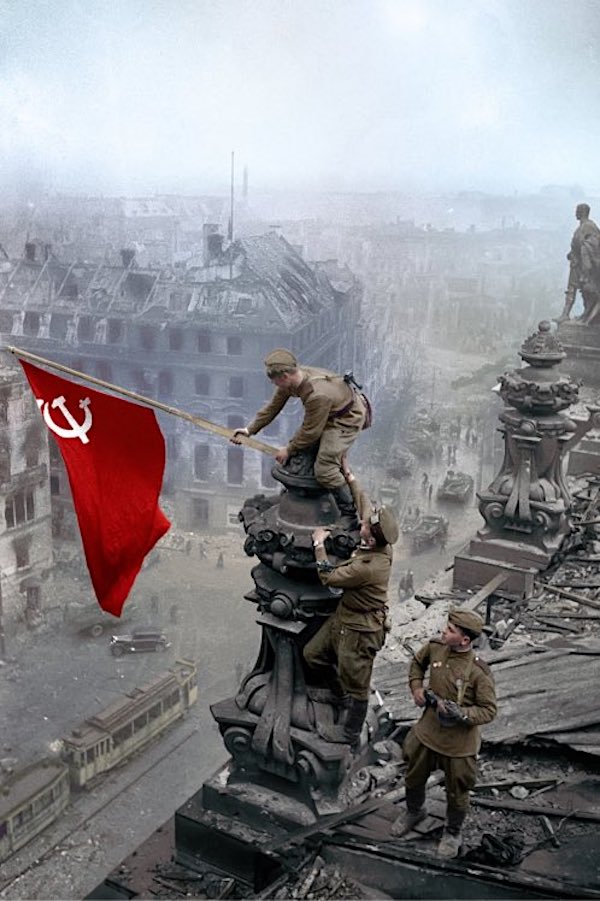
Yevgeny Khaldei – 75 years ago the Soviet banner was raised over the Reichstag. 11 million Soviet soldiers died in WW2 and three-quarters of German losses were suffered at the hands of the Red Army – May 2 1945

• At this point in time, the US has 5% of the world’s population, 33% of its COVID19 infections and 26% of deaths.
• The coronavirus death toll in the US climbs by 1,883 in the past 24 hours
• Death rates are slowing in most of Europe, but its virus death toll is over 140,000 out of 235,000 globally

• Cases 3,417,482 (+ 93,547 from yesterday’s 3,323,935)
• Deaths 239,895 (+ 5,424 from yesterday’s 234,471)

From Worldometer yesterday evening -before their day’s close-
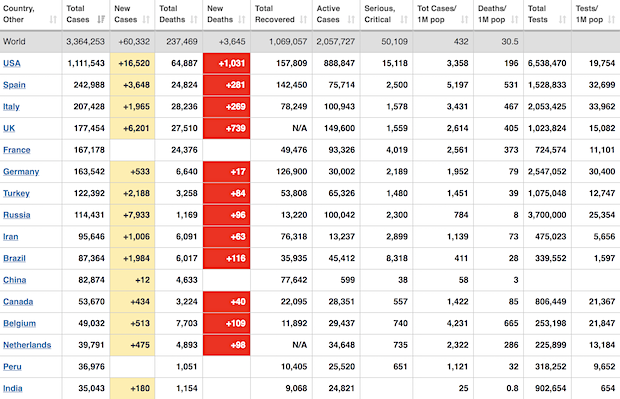
From Worldometer – Among Active cases, Serious/Critical fell to 2%
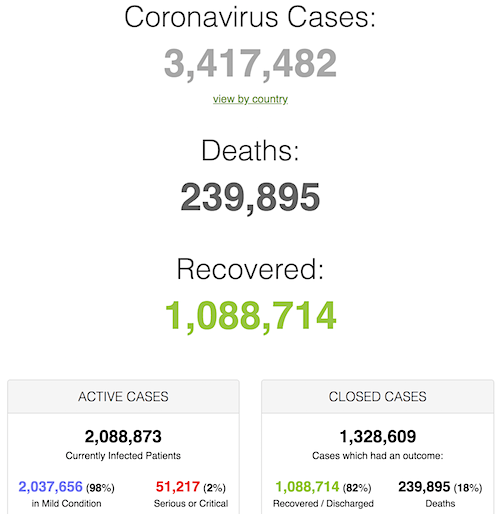
From SCMP:
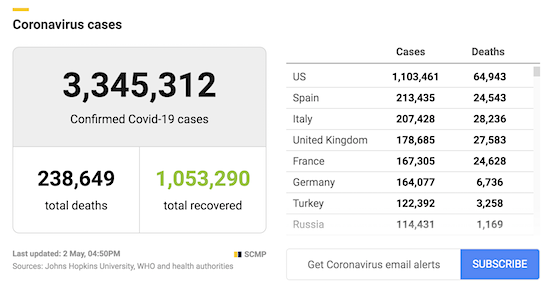
From COVID19Info.live:
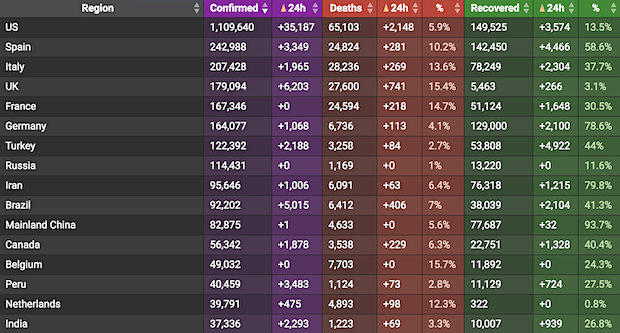

They thought it through.
• Opening Up (Yaneer Bar-Yam et al, New England Complex Systems Institute)
Before you begin to restart the economy make sure you are not starting another economic collapse. Premature relaxation of restrictions will guarantee loss of all that was gained. A premature relaxation, even briefly, would seed new transmissions that cannot be undone within weeks. Conditions and process to follow:
1) Relax restrictions locally by geographically isolated regions (not by industry group, trade or occupation). 2) Assure that travel restrictions prevent new cases from entering. Fines or repatriation may help reduce the motivation to sneak in. 3) Stop community transmission (travelers or prior case contacts that are in quarantine when they become ill do not prevent opening up). 4) Make sure sufficient testing gives ability to identify regions free of the virus. Even after cases drop sharply, widespread testing should be continued for at least another 2 weeks to prevent clustered transmission caused by individuals with a long incubation period or false negative tests.
5) There should be no new locally transmitted cases within last incubation period of 14 days. 6) Assure facilities for isolation and medical care of positively identified cases. 7) Set up contact tracing. 8) Multiple steps should be taken to stage the relaxation of restrictions and monitor for new cases. 9) Ensure masks are worn for several weeks after opening up. 10) The last steps to take in opening up are to allow public transportation and large meetings to avoid superspreader events, and to relax restrictions on high risk institutions and vulnerable populations.
Still, while restrictions are present, some things are still possible: 1) Going outdoors in an area where other people are very rare. 2) Meeting one or two people outdoors but staying 18-27 ft (6-9 m) apart (6 ft is not enough). Closer distances are possible when wind is blowing. 3) Driving and staying in your car in low density areas.
Opening schools: 1) Start with meetings outdoors with no contact between teacher and student one on one. 2) Arrange small group meetings outdoors with no contact in areas with excellent ventilation. 3) Arrange play dates with two students, preferably outdoors. If indoors, then restrict only to connection between two families that have been safely isolating for 14 days.

Subways and elevators are Russian roulette systems.
• New Yorkers Face Back-to-Work Commuting Nightmare (R.)
Staying compliant with public safety norms in particular will push the city’s subway system, which is normally used by 1.3 million commuters every day, beyond capacity, said Kevin Kelly, a senior managing director who wrote the report for Savills, a leading broker in global commercial property sales and leasing. The report was written specifically about New York but is relevant for other large cities hobbled by the pandemic and where mass transit accounts for a majority of commuter travel. Kelly called mass transit an enormous barrier to getting people back to work in Manhattan, where the car is only used by 12% of workers commuting to jobs in the U.S. financial capital.
“The biggest bottleneck is mass transit because there’s simply no good way to get people into an office in Manhattan avoiding public transit,” said Kelly, who in a prior job helped with the spatial analysis of how disease spreads geographically at the Public Health Department of Epidemiology in Los Angeles county. Understanding where people are and how they are likely to travel is critical when studying commuting, Kelly said. The mass transit constraints will force more employees to continue working from home as companies decide how best to return to offices that until a coronavirus vaccine is found need to be less dense with new rules for everyday office etiquette.
[..] Temperature screenings in lobbies, abundant hand sanitation dispensers and one- or two-person limits in elevators are some of the changes awaiting employees on their return to the office. “The subway and mass transit are a huge variable as we start to think about coming back to work, and there really isn’t any simple answer that any one business can fix,” Kelly said in an interview. The Metropolitan Transportation Authority, which operates the subway, city buses and two commuter rail lines, is hiring 100 monitors to check for overcrowding on trains and to ensure stations are functioning properly, an MTA spokesman said. The MTA also is waiting for guidance from public health authorities and has reached out to other mass transit systems around the world to glean best practices to ensure public safety, the spokesman said.
Public transportation is limited in New York during the pandemic for essential business or urgent medical appointments. On May 6, subway service will be halted daily for five hours starting at 1 a.m. so trains and stations can be disinfected. While a common subway train with 10 units typically moves up to 2,000 people at once, under social distancing that number shrinks to 200, or about what one car carries during rush hour, Kelly calculated in the report Savills published on Wednesday. The number of people who will be needed to regulate how many commuters travel in each subway car is another concern, he said. “Just the mechanics of that alone is pretty wild,” Kelly said.

The only thing remdesivir is claimed to do is shorten hospital stays (and you would still need to ask how that is measured).
It does nothing to enhance chances of survival.
• US Approves Remdesivir for Coronavirus Treatment (GR)
The experimental anti-viral drug remdesivir has been granted emergency authorization by the US’s Food and Drug Administration (FDA) on Friday to be used to treat coronavirus.The decision comes after a recent clinical trial showed the drug improved the outcomes for patients with severe Covid-19. The National Institutes of Health (NIH) in the US released data showing the remdesivir reduced hospitalization stays by 31% compared to a placebo treatment. However, the drug did not significantly improve chances of survival. Remdesivir was created by biopharmaceutical company Gilead Science, which said it will donate 1.5 million vials of the drug to help patients in hospitals in US cities hardest hit by the coronavirus.
The donation is expected to be enough for at least 140,000 patients, depending on the number of days they need to be treated. The company said due to a limited supply, hospitals with intensive care units and other hospitals the government deems most in need will receive priority. Speaking in the Oval Office on Friday, Donald Trump praised the drug and called it a “very promising situation.” Remdesivir was also touted earlier in the week by Dr. Anthony Fauci, the United States’ top infectious disease specialist, who said that clinical trials in the United States and a number of other countries, including Greece, “shows that remdesivir has a clear-cut, significant, positive effect in diminishing the time to recovery.”

So you have remdesivir which does nothing really, and you have HQC which saves lives but about which all of a sudden after 70 years warnings are issued.
• 80 Patients, Staff Infected at Texas Nursing Home, HCQ Saves All But 1 (GP)
A nursing home in Texas has a hopeful story for those suffering with coronavirus. The Resort at Texas nursing home had an outbreak of coronavirus that infected 56 residents and 33 staff members. Dr. Robin Armstrong immediately administered hydroxychloroquine to the residents and staff members along with Zpac and Zinc. Only one nursing home patient died since the doctor prescribed the hydroxychloroquine. 55 made it. FOX7 Austin reported:
“Dr. Armstrong and others at the Resort at Texas City Nursing home knew time wasn’t on their side. “Two of our residents had symptoms and that’s when we tested everybody,” said nursing home Executive Director Jan Piveral. 56 residents and 33 staff members were COVID-19 positive. “Our Goal was to make sure we could shelter them in place so we don’t spread it to other people,” Armstrong said. “Then also at the same time treat them so they would get better.” Armstrong says he knew residents who ended up in the hospital had a higher mortality rate. “Our goal was to keep them here and treat them with the medications we had available,” he said.
When Armstrong began administering Hydroxychloroquine to it was controversial but appeared promising. “If we didn’t make the decision quickly then we could potentially lose 15 to 20% of the residents which was not an option,” said the Doctor. Armstrong’s approach was to begin administering Hydroxychloroquine a Zpac and Zinc just as soon as a resident first started showing symptoms. The patients were being monitored daily. “We did EKGs on each of these patients to make sure they didn’t have the cardiac side effects that everyone talks about,” Armstrong said. “None of our patients did.”
Armstrong doesn’t call the Hydroxychloroquine a cure and is aware of all the recent reports that say the drug shouldn’t be used to treat COVID-19. But he points out only one of the nursing homes COVID-19 patients has died. “Everyone who got on treatment who started on treatment is actually doing really well,” he said.

One nursing home compared to another.
• Manhattan Nursing Home Reports 98 Coronavirus Deaths (G.)
A nursing home in New York has reported a “horrifying” death toll of 98 people from the coronavirus as residential facilities continued to emerge as a deadly source of outbreaks across the world. The death toll at the Isabella Geriatric Center in Manhattan is one of the worst such outbreaks in the United States and caused a shock even in hard-hit New York after an official state tally of nursing home deaths listed only 13 at the home as of Friday. But officials at the 705-bed centre later confirmed that up to 46 residents who tested positive for Covid-19 had died, as well as an additional 52 people suspected to have the virus, Associated Press reported. Some died at the nursing home and some died after being treated at hospitals.
“It’s absolutely horrifying,” mayor Bill de Blasio said. “It’s just impossible to imagine so many people lost in one place.” The number of bodies became so overwhelming the home ordered a refrigerator truck to store them because funeral homes have been taking days to pick up the deceased. “Isabella, like all other nursing homes in New York City, initially had limited access to widespread and consistent in-house testing to quickly diagnose our residents and staff,” Audrey Waters, a spokeswoman for the nursing home, wrote in an email. “This hampered our ability to identify those who were infected and asymptomatic, despite our efforts to swiftly separate anyone who presented symptoms.”
Isabella also encountered staffing shortages, prompting it to hire from outside agencies and early challenges securing personal protective equipment for employees. Waters said the home finally is getting more access to testing now. A survey last month of nursing homes in New York state found that 19 had reported 20 or more deaths linked to the pandemic, raising the prospect of hundreds of unattributed Covid-19 deaths in a state where almost 24,000 people have died from the disease. The state’s health department said it has received outbreak reports from 239 nursing homes, including at least six facilities with death tolls of 40 patients or more. “The one thing we now know about the nursing homes is the status quo cannot continue to say the least,” de Blasio said. “Something very different has to happen.”

Little killers. “..the number of kids testing positive for the virus in the U.S. is greater than the total number of confirmed cases in many countries, including Singapore, Ireland, and Mexico ..”
• New Research Suggests Significant Undercount Of Children With Coronavirus (IC)
In the US, the vast majority of serious Covid-19 cases — and eight out of 10 deaths — occur in people who are at least 65. Yet newly tabulated data show that the virus is also affecting young people across the country — and in very rare cases, killing them. At least 201 infected children under age 18 have been admitted into pediatric intensive care units in the U.S., according to data from a national registry called Virtual Pediatric Systems. And at least 20 people under the age of 20 have died from the coronavirus. In New York state, which has the largest number of children severely affected by the virus, 10 children who tested positive had died as of April 30, and at least 56 children had been admitted into pediatric intensive care units.
Across the U.S., more than 24,000 children have tested positive for the new coronavirus, according to state health department data compiled by a new project, CovKid, which tracks the effects of Covid-19 on children. That total represents everyone under age 20 and includes data from New York City but not New York state and Nebraska, which have not yet reported the age breakdown of coronavirus cases. While most states are not reporting the race and ethnicity of children with the coronavirus, data from California and Illinois show that more than one third of 3,049 children who tested positive were Latino.
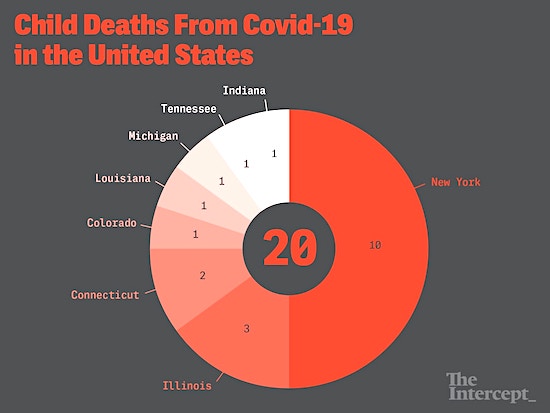
While the number of kids testing positive for the virus in the U.S. is greater than the total number of confirmed cases in many countries, including Singapore, Ireland, and Mexico, it is probably only a small fraction of all who have the disease, because of a shortage of tests and very limited testing of children. “The big question is how many kids are being tested?” said Elizabeth Pathak, an epidemiologist and director of the CovKid project. Without that information, it’s impossible to know how many are infected. So Pathak and several colleagues used clinical data from China to gauge infection rates in the U.S. and estimate that the total number of children infected in the U.S. is now at least 478,000.

After all the recent hearings, why should they comply?
• White House Blocks Dr. Fauci From Testifying To Congress (R.)
Top US health official Anthony Fauci will not testify next week to a congressional committee examining the Trump administration’s response to the coronavirus pandemic, the White House said on Friday, calling it “counterproductive” to have individuals involved in the response testify. The White House issued an emailed statement after a spokesman for the House of Representatives committee holding the hearing said the panel had been informed by Trump administration officials that Fauci had been blocked from testifying.
“While the Trump administration continues its whole-of-government response to Covid-19, including safely opening up America again and expediting vaccine development, it is counterproductive to have the very individuals involved in those efforts appearing at congressional hearings,” White House spokesman Judd Deere said in a statement. “We are committed to working with Congress to offer testimony at the appropriate time.” Fauci’s testimony was being sought for a May 6 hearing by a House Appropriations subcommittee that oversees health programmes, said spokesman Evan Hollander.

Good cop bad cop.
• No. 2 CDC Official Says US Missed Some Chances To Slow Virus (AP)
The U.S. government was slow to understand how much coronavirus was spreading from Europe, which helped drive the acceleration of outbreaks across the nation, a top health official said Friday. Limited testing and delayed travel alerts for areas outside China contributed to the jump in U.S. cases starting in late February, said Dr. Anne Schuchat, the No. 2 official at the U.S. Centers for Disease Control and Prevention. “We clearly didn’t recognize the full importations that were happening,” Schuchat told The Associated Press. [..] The CDC on Friday published an article, authored by Schuchat, that looked back on the U.S. response, recapping some of the major decisions and events of the last few months. It suggests the nation’s top public health agency missed opportunities to slow the spread.
Some public health experts saw it as important assessment by one of the nation’s most respected public health doctors. The CDC is responsible for the recognition, tracking and prevention of just such a disease. But the agency has had a low profile during this pandemic, with White House officials controlling communications and leading most press briefings. “The degree to which CDC’s public presence has been so diminished … is one of the most striking and frankly puzzling aspects of the federal government’s response,” said Jason Schwartz, assistant professor of health policy at the Yale School of Public Health.
[..] in her article, Schuchat noted that nearly 2 million travelers arrived in the U.S. from Italy and other European countries during February. The U.S. government didn’t block travel from there until March 11. “The extensive travel from Europe, once Europe was having outbreaks, really accelerated our importations and the rapid spread,” she told the AP. ”I think the timing of our travel alerts should have been earlier.”

Crazy choices to make.
• Cardiologists Forced To Adapt To COVID-Linked Surge In Heart Symptoms (TPM)
Apart from the disease’s more well-known ravaging of the respiratory system, significant numbers of COVID-19 patients arrive at hospitals with serious heart problems, many of which first appear to be those of a heart attack but turn out to be symptoms of the coronavirus or the body’s response to it. So doctors on the frontline of the COVID-19 pandemic have adapted, relying on new medical research from foreign hotspots like Wuhan and Lombardy to contend with how little we still know about the virus itself. Many hospital cardiology departments, for example, have begun to take potential heart attack patients with suspected COVID-19 into their ERs to first determine whether they have contracted the virus before moving “them back into the cardiac care path,” Thomas Maddox, chair of the American College of Cardiology’s Science and Quality Committee, told TPM.
He added that in hotspots like New York City, hospitals had “moved to a lower threshold: to test, and wait until it comes back, before doing anything with the patient.” Maddox described the dilemma to TPM as a decision between bad variables. On the one hand, treating a COVID patient presenting heart symptoms as if he had a heart attack could expose the doctor. On the other, treating all patients as if they were infected with COVID could deprive those suffering from heart attacks of precious minutes. “It’s been so hard to solve,” Maddox added. “Because, at the same time, you don’t want to take somebody who is short of breath because they’re having a heart attack and delay their treatment because you send them to a COVID unit, and miss the opportunity to help out their heart.”
The symptoms appear in different ways, experts told TPM. Some patients struggle with blood clots that course throughout their body, while others have severely inflamed hearts. Others still face organ failure amid spiraling blood oxygen levels. “There’s not an easy way to tell, though, if they’re presenting so much like a heart attack,” Gulati told TPM. “We’re seeing reports of myocardial infarction when they have COVID-19, but often they aren’t always having blockages of the coronary arteries that we traditionally expect.” She added that, in COVID-19 patients, lack of blood oxygen can creep up fast, overtaxing the heart. “They are sitting there talking to you, and suddenly they go incredibly bad,” Gulati said, speaking of patients with dangerously low blood oxygen levels.
“That is a big demand on the heart, if the heart is not getting enough oxygen, and the organs aren’t getting enough oxygen. As a result, everything is compromised.” Preliminary mortality data released by the Centers for Disease Control suggests that, as the pandemic peaked in New York City, the number of people dying due to what the CDC classifies as “diseases of the heart” also peaked.
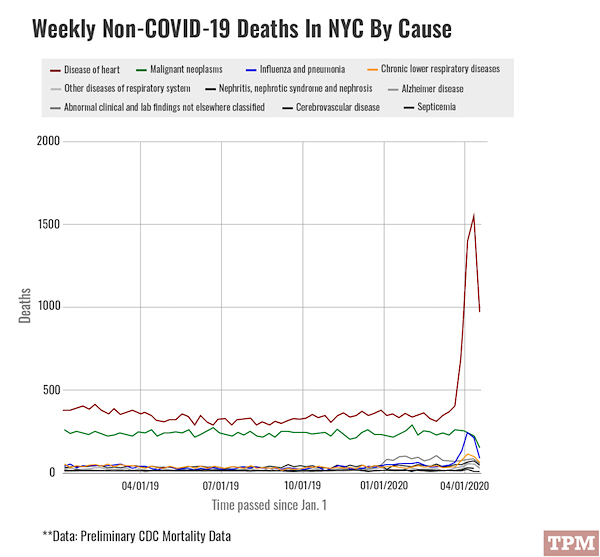

Critical care is not a happy place.
• Over 70% Of UK COVID19 Patients In Critical Care Are Men (PA)
More than 70% of patients with coronavirus admitted to critical care are men, according to new data. The figures come from the UK’s Intensive Care National Audit and Research Centre (ICNARC) and were based on a sample of 7,542 critically-ill patients confirmed as having Covid-19. Researchers found that 5,389 of these patients were men and 2,149 were women. The report, published on Friday, also found that men were more likely to die in intensive care, with 51% dying compared to about 43% of the women who were admitted. The report analysed data on patients with confirmed Covid-19 from 286 NHS critical care units in England, Wales and Northern Ireland taking part in the ICNARC programme up to 4pm on Thursday.
The new data echoes comments of a leading expert who said that Covid-19 was just as deadly as Ebola for people admitted to hospital in the UK. Prof Calum Semple from the University of Liverpool, a consultant respiratory paediatrician at Alder Hey children’s hospital and chief investigator on a study published on Wednesday, said the data highlighted the danger of coronavirus. Research by Semple and his team found that of the total number of coronavirus patients admitted to hospital, 17% required admission to high dependency or intensive care units and of these, 31% were discharged alive, 45% died and 24% continued to be treated in hospital.
Semple explained: “Some people persist in believing that Covid-19 is no worse than a bad dose of flu. “They are gravely mistaken. Despite the best supportive care that we can provide, the crude case fatality rate for people who are admitted to hospital – that is, the proportion of people ill enough to need hospital treatment who then die – with severe Covid-19 is 35 to 40%, which is similar to that for people admitted to hospital with Ebola. It’s a really nasty disease.” The new ICNARC data also showed that around 56% of 60 to 69-year-olds, 67% of 70 to 79-year-olds, and 65% of people aged 80 and over admitted to critical care died there, compared to about 24% of people aged under 50.

The article talks about bacteria, microbes, but not viruses. Do the people at Business Insider know the difference?
• Hong Kong Airport Is Rolling Out Full-Body 40-Second Disinfectant Booths (BI)
In an effort to prevent further spread of coronavirus, Hong Kong International Airport is testing a new machine that would effectively sanitize passengers head to toe. The CLeanTech machine acts as a full-body disinfectant, killing bacteria on people’s bodies and clothing. The cleaning, which takes 40 seconds, uses an antimicrobial coating on the interior surface of the machine as well as sanitizing spray for “instant disinfection,” according to a press release shared by the airport. The machine is kept at “negative pressure to prevent cross-contamination between the outside and inside environment.” Anyone who steps inside first goes through a temperature check.
The machine is currently being used by airport staff who specifically handle public health issues for arriving passengers there. [..] In addition to the full-body machine, the Hong Kong airport has introduced other cleaning measures to assure passengers. The AA said it was piloting an invisible antimicrobial coating sprayed in all passenger facilities, including high-touch surfaces like check-in kiosks and baggage carts. And cleaning robots equipped with ultraviolet light and air sterilizers are being deployed to public areas. According to the AA, the robots can sterilize up to 99.99% of bacteria in the air and on surfaces in 10 minutes.

It doesn’t get more American than this. Cash in the billions and fire them anyway.
• Sen. Hawley Calls Out United Airlines For Cutting Wages, Benefits (DC)
Sen. Josh Hawley railed against United Airlines on Friday after employees supposedly told him the company is cutting back their wages and benefits after receiving stimulus money amid economic lockdowns. “Employees have told me the company is cutting their hours, pay & benefits immediately,” he wrote on Twitter after recalling an interaction with United Airlines employees at an airport on his way to Washington, D.C. UA, American Airlines, Southwest Airlines, and Delta Airlines were among a handful of airline companies that accepted stimulus money, reports show. Hawley added: “This is AFTER United took billions in bailout money that was earmarked for workers. This has better not be true.”
[..] President Donald Trump signed the $2 trillion stimulus bill in March, which, among other things, includes more than $58 billion to bolster the aviation industry, with a sizable portion of it sectioned off to fund employee payroll costs through September, CNN reported April 14. The airline industry saw enormous losses after governors and mayors instituted lockdowns to slow the pandemic spread. Passenger counts have dropped nearly 100%, forcing airlines to cancel more than 70% of their flights as the international airline association estimates worldwide industry losses of $314 billion. Hawley, for his part, has been on a tear against corporate entities recently.

Ok, maybe this is even more American. It is May, and Amazon is finally going to protect the workers it has exposed to the virus in slavery-like conditions.
But the company is not going to pay for that. The shareholders are.
If Bezos were a normal person, he would have paid for it all from his own pocket months ago, but you don’t get to be the richest man in the world if there’s a conscience in the way.
• Amazon Tells Investors They ‘May Want To Take A Seat’ (CNBC)
Long-time Amazon investors shouldn’t have been surprised by a jarring quote in the company’s first-quarter earnings report Thursday: “If you’re a shareowner in Amazon, you may want to take a seat.” That’s because Amazon has been giving investors some version of that warning since it went public in 1997, letting them know it would prioritize long-term business advantages over short-term gains. Amazon said Thursday it would invest its expected $4 billion second-quarter profit in coronavirus-related efforts, including buying personal protective equipment for workers, stepping up cleaning in its facilities and building its own testing capability.
The company said that due to the investment, it expects operating income for the quarter to be as high as $1.5 billion or as low as a loss of $1.5 billion. The bold step is reflective of CEO Jeff Bezos’ approach since starting the business. “We believe that a fundamental measure of our success will be the shareholder value we create over the long term,” Bezos told shareholders in a letter shortly after its IPO. “This value will be a direct result of our ability to extend and solidify our current market leadership position.” Even back then, with the stock trading in the low double digits, Bezos warned shareholders its decisions would not look like those of other companies.
“We will make bold rather than timid investment decisions where we see a sufficient probability of gaining market leadership advantages,” Bezos wrote in the 1997 letter. “Some of these investments will pay off, others will not, and we will have learned another valuable lesson in either case.” Thursday’s earnings report acknowledged “these aren’t normal circumstances” and Amazon is “not thinking small.” “There is a lot of uncertainty in the world right now, and the best investment we can make is in the safety and well-being of our hundreds of thousands of employees,” Bezos said in a statement in the earnings release.

There are other things in the news today that I would reserve the term bone-chilling for.
• Bone-Chilling WTF Charts of the Collapse in US Fuel Demand (WS)
For gasoline, it started in mid-March when the measures to tamp down on the spread of the coronavirus took effect. For jet fuel, it started in mid-February as flight cancellation from the US to China, and then to other countries took effect. We can see this in the weekly data provided by the EIA. The EIA measures weekly consumption in terms of product supplied, such as by refineries and blenders, not by retail sales. Consumption of motor gasoline was still up 3.1% in the week ended March 13, compared to the same week last year, according to EIA data. But then demand just collapsed. In the week ended April 3, gasoline demand was down 48% compared to the same week a year earlier:
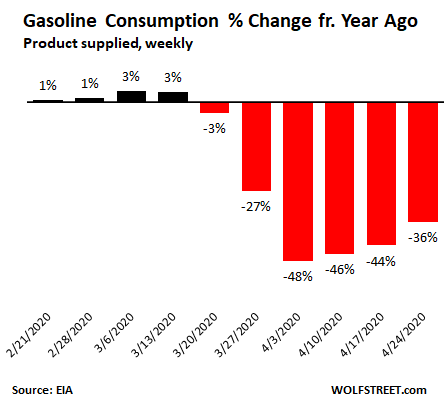
In terms of barrels per day (b/d), demand for motor gasoline was well above 9 million b/d in the four weeks up to mid-March, but then demand collapsed, down to 5.07 million b/d in the week ended April 3. Then demand ticked up. By the week ended April 24, demand was 5.86 million b/d. Those last four weeks were by far the lowest on record in the EIA’s data going back to 1991:
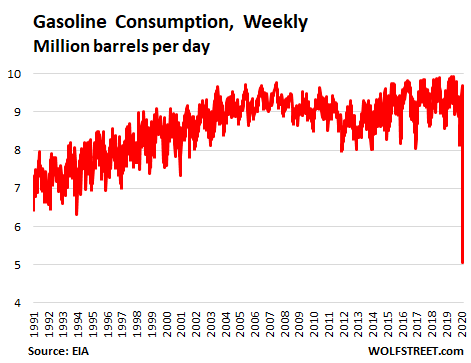
Consumption of jet fuel (kerosene type) collapsed even more, peaking, if you will, in the week ended April 10 with a 72% year-over-year plunge. The decline in jet fuel demand started earlier than with gasoline, as flight cancellations were starting in the second half of February:
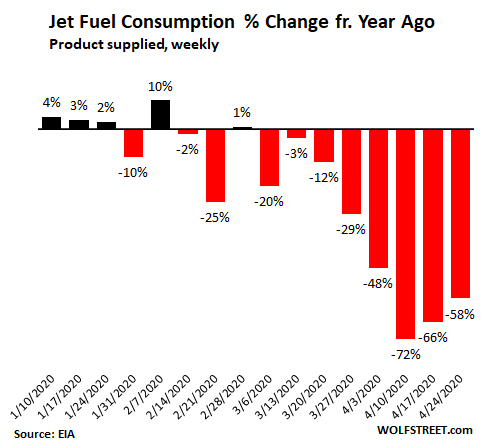
In terms of barrels per day, demand for jet fuel collapsed to just 463,000 b/d in the week ended April 10. The last four weeks – ranging from 463,000 b/d to 800,000 b/d – were by far the lowest in the data going back to 1991:
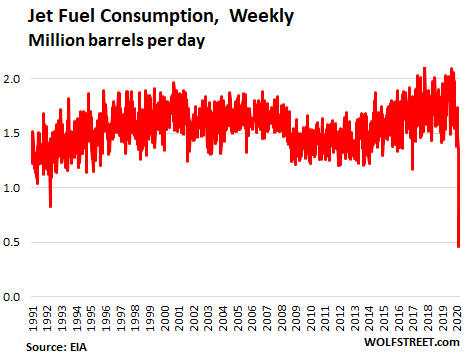
[..] Combined, gasoline, jet fuel, and distillate consumption, plunged by 22% to 43% over the last four weeks. In terms of barrel per day, the combined consumption collapsed to a low of 8.3 million b/d in the week ended April 10 and has ticked up since then. The last four weeks, ranging from 8.3 million b/d to 9.8 million b/d, were by far the lowest in the data going back to 1991:


There was never anything wrong with Flynn’s conversations with Russian ambassador Sergey Kislyak.
Strzok, Page, Comey, McCabe, Brennan should be forced to compensate Flynn out of their own savings. But he’s going to ask for $1 billion, so the state will have to pay instead.
• Slouching Toward Resolution (Jim Kunstler)
General Flynn had been an irritant to the Obama administration in his role as chief of the Defense Intelligence Agency. He disagreed with a lot going on around him and he said so, especially the nuclear deal that was percolating with Iran. Mr. Obama canned General Flynn in 2014. Afterward, CIA chief John Brennan and DNI James Clapper put him under surveillance and played entrapment games with him, using some of the same shady characters (Stefan Halper, Richard Dearlove) who later showed up as RussiaGate players. In early 2016, Gen. Flynn joined the Trump campaign as a foreign affairs advisor and that summer made the mistake of leading the “Lock her up,” chant to a delirious crowd at the Republican Convention.
Perhaps he knew a thing or two about the activities of the Clinton Foundation. Perhaps he also knew what Jeffrey Epstein was up to. Then Mr. Trump shocked the world and won the election. Gen. Flynn was soon appointed incoming National Security Advisor. One can imagine the anxiety crackling through a Democrat-controlled Deep State on the verge of surrendering power to its enemies. The alarm bells that went off through the vast US Intel underground must have been deafening. In a panic, the Intel Community set in motion a suite of operations to get rid of both Flynn and Trump. On December 29, late in the transition-of-power, President Obama lit up a diplomatic flare by confiscating country retreat properties in Maryland and Long Island owned by the Russian embassy and expelling 35 embassy employees, supposedly as payback for Russia “interfering in the 2016 election.”
This prompted a conversation between incoming National Security Advisor Flynn and Russian ambassador Sergey Kislyak. That cued the FBI to entrap General Flynn. The news media played along with the preposterous falsehood that high American officials should not communicate with diplomats posted to the USA. The shady gotcha interview about that with Flynn, conducted by FBI officers Peter Strzok and Joseph Pientka, has been dissected to death, so I’ll spare you that, except to say that it was carried out in obvious bad faith.

The mother of Julian’s children.
• Why Julian Assange Must Urgently Be Freed (Stella Moris)
Forming a family with Julian under the circumstances was always going to be difficult, but our hopes eclipsed our fears. Initially, Julian and I managed to carve out a space for a private life. Our firstborn visited with the help of a friend. But when Gabriel was six months old, an embassy security contractor confessed to me that he had been told to steal the baby’s DNA through a nappy. Failing that they would take the baby’s pacifier. The whistleblower warned me Gabriel should not come into the embassy anymore. It was not safe. I realised that all the precautions I had taken, from piling layers on to disguise my bump to changing my name, would not protect us. We were totally exposed. These forces operated in a legal and ethical vacuum that engulfed us.
I could write volumes about what happened in the months that followed. By the time I was pregnant with Max the pressure and harassment had become unbearable and I feared that my pregnancy was at risk. When I was six months pregnant Julian and I decided I should stop going into the embassy. The next time I saw him was in Belmarsh prison. The image of Julian being carried out of the embassy shocked many. It struck a blow to my chest, but it did not shock me. What happened that morning was an extension of what had been going on inside the embassy over an eighteen-month period. After Julian was arrested a year ago, Spain’s High Court opened an investigation into the security company that had been operating inside the embassy.
Several whistleblowers came forward and have informed law enforcement of unlawful activities against Julian and his lawyers, both inside and outside the embassy. They are cooperating with law enforcement and have provided investigators with large amounts of data. The investigation has revealed that the company had been moonlighting for a US company closely associated with the current US administration and US intelligence agencies and that the increasingly disturbing instructions, such as following my mother or the baby DNA directive, had come from their US client, not Ecuador. Around the same time that I had been approached about the targeting of our baby, the company was thrashing out even more sinister plans concerning Julian’s life. Their alleged plots to poison or abduct Julian have been raised in UK extradition proceedings.

We try to run the Automatic Earth on people’s kind donations. Since their revenue has collapsed, ads no longer pay for all you read, and your support is now an integral part of the process.
Thanks for your generosity.

The FBI found "no derogatory information" about @GenFlynn. But they decided to crush him anyway.
"There is nothing worse than this. It's how the secret police operate in third world dictatorships and it's exactly how Peter Strzok operated. And then he lied about it extensively." pic.twitter.com/a2W9wP15Zk
— Trump War Room – Text TRUMP to 88022 (@TrumpWarRoom) May 1, 2020

Bench in library of Alexandria, Egypt


Support the Automatic Earth for your own good.








Home › Forums › Debt Rattle May 2 2020